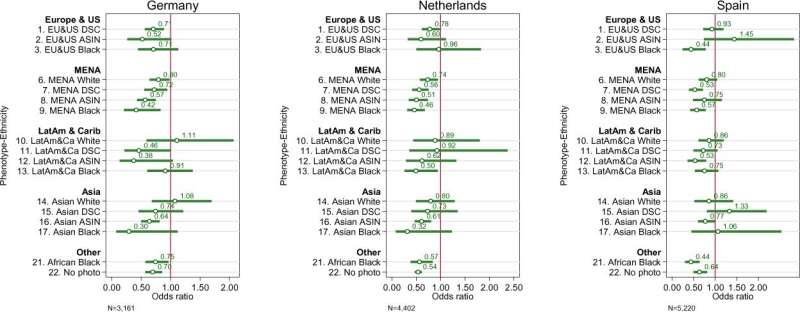Study analyzes racial discrimination in job recruitment in Europe

The largest study on racial discrimination in job recruitment in Europe reveals that having a non-white phenotype is a major obstacle to finding employment for Europeans born to immigrant parents. This is one of the main conclusions of a study carried out by the Universidad Carlos III de Madrid (UC3M) in collaboration with the University of Amsterdam, the Berlin Social Science Centre (WZB) and the German Centre for Integration and Migration Research (DeZIM).
Previous research on the incorporation of international immigrants and their descendants into the job market in Europe has identified having Muslim background as the main trigger of prejudice and discrimination. However, this research has not taken into account the role of physical appearance as a potential barrier to employment. To fill this gap, this new study analyzed the extent to which belonging to a “visible” minority (that is, having a non-white phenotype) is an additional source of discrimination against descendants of international immigrants in Europe.
This study, published in the journal Socio-Economic Review, shows that having a black or Asian/Indigenous American phenotype reduces the likelihood that the employer will be interested in the candidate by approximately 20% (averaged across the three countries in the study: Germany, Spain and the Netherlands), while having a dark-skinned Caucasian phenotype (very prevalent in North Africa) reduces this averaged likelihood by approximately 10%, when compared to having a white phenotype.
These estimates capture the effect of applicants’ phenotype on European employers’ responses, once isolated from the effect of the applicants’ region of ancestry. However, the study also shows that the combined effect of ethnic background and phenotype can lead to serious levels of discrimination in Europe.
To carry out the study, researchers analyzed the responses of almost 13,000 European companies to fictitious job applications in these three European countries where attaching a photograph to CVs is a common practice. The researchers changed the names and photographs that appeared on the fictitious job applications (keeping all other CV characteristics identical) which were submitted to real vacancies for a wide range of occupations.
All fictitious applicants were young European country nationals (with the nationality of the country of the experiment) born to parents from four major regions of the world (Europe-U.S., Maghreb-Middle East, Latin America-Caribbean and Asia). This ethnic ancestry was indicated in the CVs mainly through the applicants’ full names.
The photographs used in the CVs were carefully selected to be comparable in physical attractiveness, but varied crucially in racial appearance across four phenotypic groups (labeled “Black”, “Asian/Indigenous American” “Dark-skinned Caucasian” and “White Caucasian”). This design enabled the researchers to obtain the first estimates of racial discrimination comparable across countries recorded in the field-experimental literature.
“Most of what we knew about racial discrimination in job recruitment to date came from Anglo countries, especially the US, where the use of photographs in job applications is prohibited by law. This forced researchers to estimate racial discrimination using only the applicants’ names, which is very problematic. A crucial advantage of our study is that we investigated the role of phenotype and ethnic background as potentially different triggers of discrimination by exploiting plausible phenotypic variation in large regions of ancestry,” explains the study’s leading author, Javier Polavieja, Banco Santander Professor of Sociology at UC3M, where he runs the Laboratory on Discrimination and Inequality (D-Lab).
“According to our estimates, in the three countries studied, applicants of Maghreb and Middle Eastern descent with black phenotypes have to submit approximately fifty percent more applications to receive a call from employers than applicants with identical CVs but with European namesand white phenotypes. These estimates of discrimination are comparable in size, if not superior, to those usually found in the case of African Americans in the United States. Discrimination against applicants with black phenotypes and European or American parents is somewhat lower but also significant,” explains Susanne Veit, director of the DeZIM laboratory and one of the study’s co-authors.
Country differences
The researchers also analyzed patterns of racial discrimination in the three countries in the experiment and found some significant differences between Spain and the two northern countries.
“Our results suggest that phenotype acts as an autonomous trigger of discrimination in Germany and the Netherlands, reducing employment opportunities for non-white applicants regardless of their parental origin. However, in Spain discrimination seems to be restricted to certain combinations of phenotype and ancestry, particularly those in which applicants’ physical appearance is most prototypical of their region of ancestry,” says Javier Polavieja.
“This doesn’t mean that phenotype is irrelevant in Spain, it isn’t at all; it only means that its effect on employers’ responses seems more difficult to disentangle from the effect of applicants’ ethnic ancestry,” he clarifies.
More information:
Javier G Polavieja et al, In your face: a comparative field experiment on racial discrimination in Europe, Socio-Economic Review (2023). DOI: 10.1093/ser/mwad009
Citation:
Study analyzes racial discrimination in job recruitment in Europe (2023, April 17)
retrieved 18 April 2023
from https://phys.org/news/2023-04-racial-discrimination-job-europe.html
This document is subject to copyright. Apart from any fair dealing for the purpose of private study or research, no
part may be reproduced without the written permission. The content is provided for information purposes only.
For all the latest Science News Click Here
For the latest news and updates, follow us on Google News.

